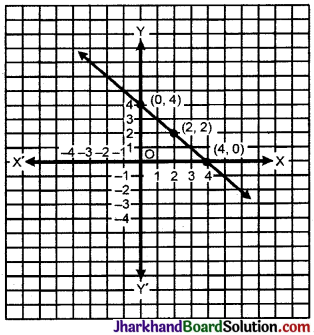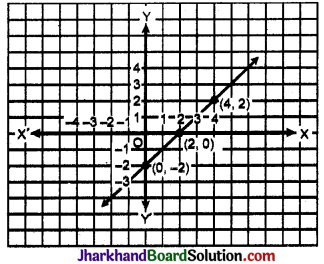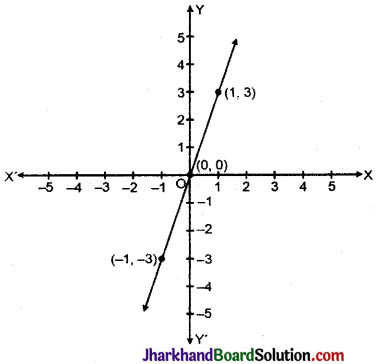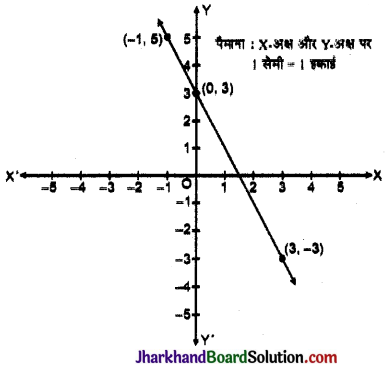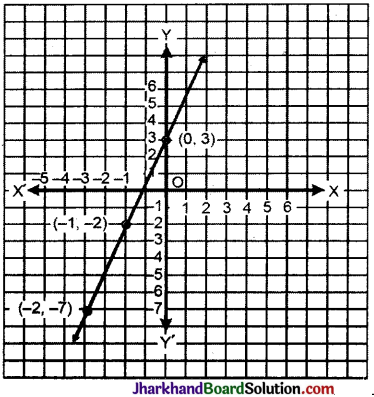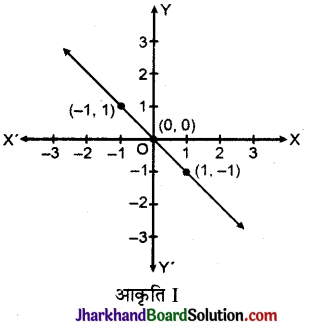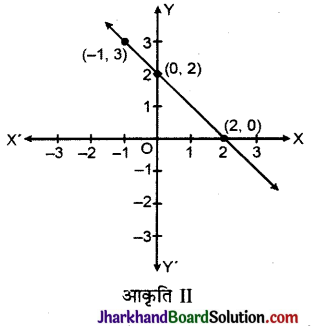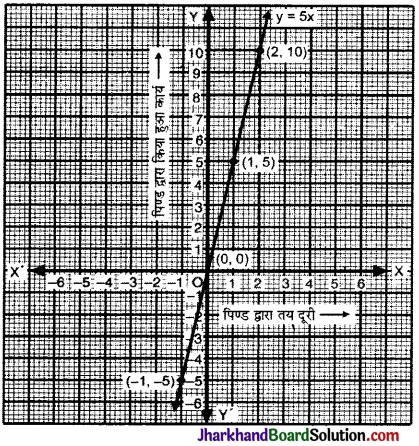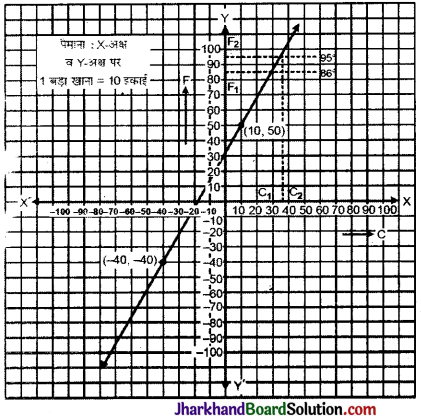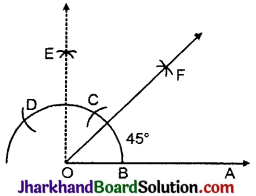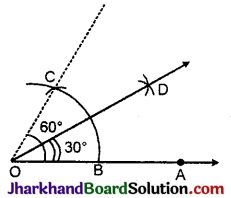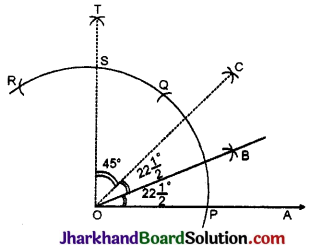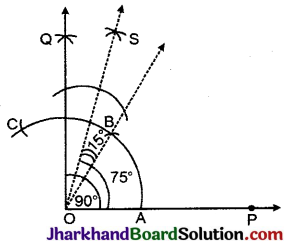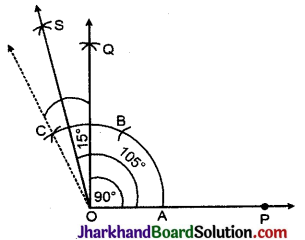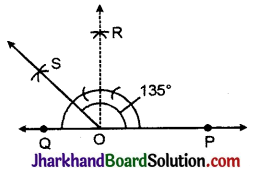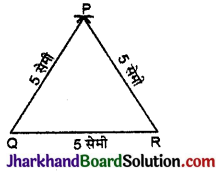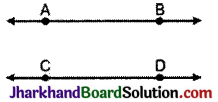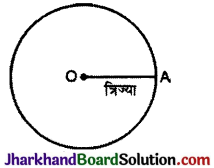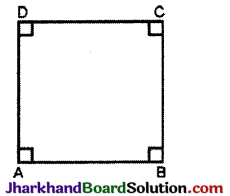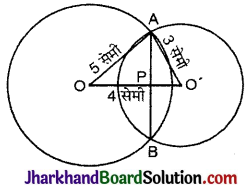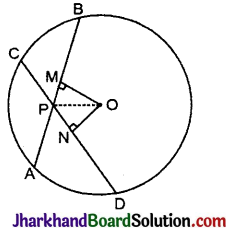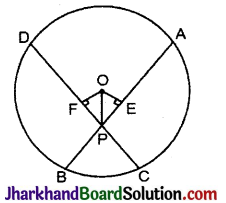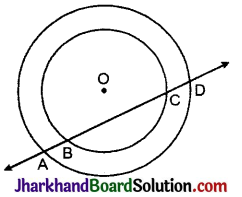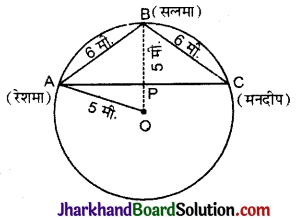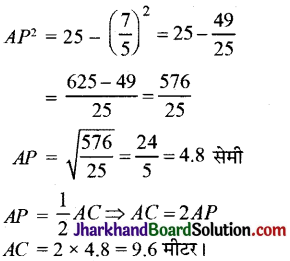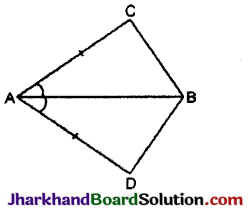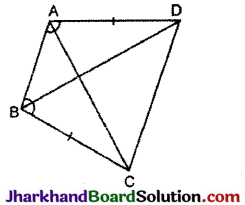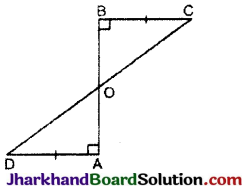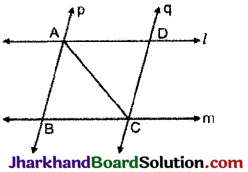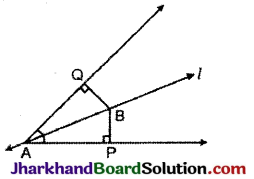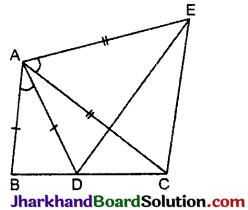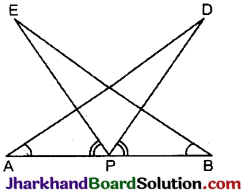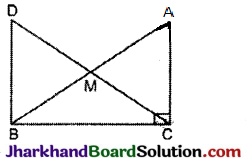Jharkhand Board JAC Class 9 English Solutions Beehive Chapter 5 The Snake and the Mirror Textbook Exercise Questions and Answers.
JAC Board Class 9 English Solutions Beehive Chapter 5 The Snake and the Mirror
JAC Class 9 English The Snake and the Mirror Textbook Questions and Answers
Thinking About the Text
I. Discuss in pairs and answer each question below in a short paragraph (in around 30-40 words).
जोड़े बनाकर विचार-विमर्श कीजिये तथा नीचे दिये गये प्रत्येक प्रश्न का उत्तर एक संक्षिप्त अनुच्छेद (लगभग 30 से 40 शब्दों) में दीजिये ।
Question 1.
‘The sound was a familiar one.’ What sound did the doctor hear ? What did he think it was? How many times did he hear it? (Find the places in the text.) When and why did the sounds stop ?
‘ध्वनि परिचित थी ।’ डॉक्टर ने कौन-सी आवाज सुनी ? उसने उसे ( आवाज को) क्या समझा ? उसे वह कितनी बार सुनाई पड़ी ? (पाठ में से उन स्थानों को ढूँढ़िये ) । वह ध्वनि कब और क्यों बन्द हो गई ?
Answer:
The doctor heard the familiar sound of rats. He heard a noise from above. When he opened the door, he thought that the sound was made by the rats in the tiled roof. He heard the sound four times, three times from above and one dull thud sound. When the doctor sat in the chair, the sound from above stopped because the snake was about to jump on the ground at that time.
डाक्टर ने चूहों की चिर-परिचित आवाज सुनी। डॉक्टर ने ऊपर एक आवाज सुनी, जब उसने दरवाजा खोला। उसने सोचा कि खपरैल की छत में चूहों द्वारा आवाज की जा रही है । उसने यह आवाज चार बार सुनी तीन बार ऊपर से और एक धीमी सी धम्म की आवाज सुनी । जब डाक्टर कुर्सी पर बैठ गया तो ऊपर की आवाज बन्द हो गई क्योंकि उस समय साँप जमीन पर कूदने ही वाला था ।

Question 2.
What two ‘important’ and ‘ earth shaking’ decisions did the doctor take while he was looking into the mirror ?
डॉक्टर ने दर्पण में देखते हुए कौन-से दो महत्त्वपूर्ण निर्णय लिये ?
Answer:
The doctor took two important decisions while he was looking into the mirror-
- He would shave daily and grow a thin moustache to look more handsome.
- He would always keep an attractive smile on his face to look more handsome.
डॉक्टर ने दर्पण में देखते हुए दो महत्त्वपूर्ण निर्णय लिए-
- वह अधिक सुन्दर दिखने के लिए रोज दाढ़ी बनायेगा और पतली मूँछें रखेगा ।
- वह अधिक सुन्दर दिखने के लिए हमेशा अपने चेहरे पर आकर्षक मुस्कान बनाए रखेगा ।
Question 3.
“I looked into the mirror and smiled,” says the doctor. A little later he says, “I forgot my danger and smiled feebly at myself.” What is the doctor’s opinion about himself when – (i) he first smiles, and (ii) he smiles again? In what way do his thoughts change in between, and why?
डॉक्टर कहता है, “मैंने दर्पण देखा और मुस्कुराया “। कुछ देर पश्चात् वह कहता है, “मैं खतरे को भूल गया और हल्के से अपने ऊपर मुस्कुराया ।” डॉक्टर की अपने बारे में क्या राय है जब वह
(i) पहली बार मुस्कुराता है और
(ii) वह दूसरी बार मुस्कुराता है’ ? इस बीच उसके विचार कैसे और क्यों बदल जाते हैं ?
Answer:
When the doctor first looks into the mirror, he smiles as he thinks he is an attractive bachelor doctor. The next time he smiles at himself because he feels he is a poor, foolish and stupid doctor. His vanity changes into humility. His thoughts got changed because of snake. He was quite near to death.
जब डॉक्टर दर्पण में देखता है तो वह मुस्कुराता है क्योंकि वह समझता है कि वह एक आकर्षक कुँआरा डॉक्टर है । अगली बार वह स्वयं पर इसलिए मुस्कुराता है क्योंकि वह महसूस करता है कि वह गरीब, मूर्ख तथा बुद्ध डॉक्टर है । उसका घमण्ड आत्मग्लानि में बदल जाता है। उसके विचार सर्प के कारण बदल गये। वह मृत्यु के बिल्कुल नजदीक था ।

II. This story about a frightening incident is narrated in a humorous way. What makes it humorous?
(Think of the contrasts it presents between dreams and reality. Some of them are listed below):
एकं भयावह घटना वाली यह कहानी हास्यप्रद ढंग से सुनाई गई है । यह किस कारण हास्यप्रद है ? (उन विरोधाभासों के विषय में सोचिये जो इस कहानी में स्वप्नों एवं वास्तविकता के मध्य प्रस्तुत किये गये हैं। उनमें से कुछ नीचे दिये गये हैं
1. (i) The kind of person the doctor is (money, possessions)
डॉक्टर जिस प्रकार का आदमी है ( धन, सम्पत्ति )
(ii) The kind of person he wants to be (appearance, ambition)
वह जिस प्रकार का व्यक्ति बनना चाहता है ( स्वरूप, महत्त्वाकांक्षा )
2. (i) The person he wants to marry
वह व्यक्ति जिससे वह विवाह करना चाहता है
(ii) The person he actually marries
वह व्यक्ति जिससे वह वास्तव में विवाह करता
3. (i) His thoughts when he looks into the mirror
दर्पण में देखते समय उसके विचार
(ii) His thoughts when the snake is coiled around his arm
जब सर्प उसकी बाँह पर लिपट जाता है तब उसके विचार
Write short paragraphs on each of these to get your answer:
उत्तर पाने के लिए इनमें से प्रत्येक पर एक संक्षिप्त अनुच्छेद लिखिये :
Answer:
1. The doctor is a poor person. He has not sufficient money. He has about sixty rupees in his suitcase. He lives in an unelectrified rented house. He has just started his medical practice. He wants to be rich. He also likes to have a good appearance. That’s why he decides to grow a thin moustache.
डॉक्टर एक ́ निर्धन व्यक्ति है । उसके पास पर्याप्त धन नहीं है । उसके पास सूटकेस में लगभग साठ रुपये हैं। वह बिना बिजली वाले किराए के छोटे से मकान में रहता है । उसने डॉक्टरी अभी शुरू की है । वह धनवान बनना चाहता है । वह आकर्षक भी दिखना चाहता है । इसलिए वह पतली मूँछ उगाना चाहता है ।
2. The doctor wants to marry a woman doctor with a good medical practice and having a lot of money. She should be fat so that she may not run after him for his silly mistake and catch him. He actually marries a thin reedy woman. She has the gift of a sprinter.
डॉक्टर एक ऐसी महिला डॉक्टर से शादी करना चाहता है जिसका चिकित्सकीय व्यवसाय ठीक चलता हो और उसके पास बहुत सा धन हो । वह मोटी हो ताकि वह (पत्नी) उसकी किसी मूर्खतापूर्ण गलती के लिये उसे (डॉक्टर को) पकड़ने के लिए उसके पीछे न भाग सके । वास्तव में उसकी शादी एक अत्यन्त पतली महिला से होती है । उसमें (पत्नी में ) एक धावक की प्रतिभा है ।

3. When he looks into the mirror, his thoughts are full of joy and satisfaction. He decides to grow a thin moustache and keep smile on his face. He finds his smile attractive. When the snake is coiled around his arm, he suddenly turns to a stone. He sits like a stone image in the flesh holding his breath. However, his mind is very active. He feels the great presence of God, the Creator. He decides to write the words ‘O God’ outside his little heart. These contrasts make the story humorous and we can’t help laughing while reading it.
जब वह दर्पण में देखता है तब उसके विचार आनन्द और संतोष से परिपूर्ण हैं । वह पतली मूँछ उगाना. चाहता है और अपने चेहरे पर मुस्कान रखना चाहता है । उसे अपनी मुस्कुराहट बहुत आकर्षक लगती है । जब सर्प उसकी बाँह पर लिपट जाता है तब वह अचानक पत्थर में बदल जाता है । वह शरीर में पत्थर की मूर्ति की तरह अपनी साँस रोककर बैठ जाता है । लेकिन उसका दिमाग बहुत सक्रिय है । वह सृष्टिकर्ता (संसार के रचयिता ) भगवान की उपस्थिति महसूस करता है । वह अपने छोटे-से दिल के बाहर ‘O God’ लिखने का निश्चय करता है । ये विरोधाभास कहानी को हास्यप्रद बनाते हैं और हम इसे पढ़ते समय हँसे बिना नहीं रह सकते ।
Thinking about Language
I. Here are some sentences from the text. Say which of them tell you, that the author :
(a) was afraid of the snake
(b) was proud of his appearance
(c) had a sense of humour
(d) was no longer afraid of the snake.
यहाँ पाठ में से कुछ वाक्य दिये गये हैं । इनमें से कौन-से वाक्य बताते हैं कि लेखक-
(a) सर्प से भयभीत था
(b) (उसे) अपने रूप पर गर्व था
(c) (उसमें) हास्य का भाव था
(d) अब सर्प से भयभीत नहीं था ।
1. I was turned to stone.
2. I was no mere image cut in granite.
3. The arm was beginning to be drained of strength.
4. I tried in my imagination to write in bright letters outside my little heart the words, “O God”.
5. I didn’t tremble. I didn’t cry out.
6. I looked into the mirror and smiled. It was an attractive smile.
7. I was suddenly a man of flesh and blood..
8. I was after all a bachelor, and a doctor too on top of it!
9. The fellow had such a sense of cleanliness…! The rascal could have taken it and used it after washing it with soap and water.
10. Was it trying to make an important decision about growing a moustache or using eye shadow and mascara or wearing a vermilion spot on its forehead?
Answer:
1. Sentences No. 1, 3, 4 and 5 tell us that the author was afraid of the snake.
2. Sentences No. 6 and 8 tell us that the author was proud of his appearance.
3. Sentences No. 9 and 10 tell us that the author had a sense of humour.
4. Sentences No. 2 and 7 tell us that the author was no longer afraid of the snake.
II. Expressions used to show fear :
भय दर्शाने के लिए प्रयुक्त अभिव्यक्तियाँ :
Can you find the expressions in the story that tell you that the author was frightened? Read the story and complete the following sentences:
क्या आप कहानी में से उन अभिव्यक्तियों को ढूँढ़ सकते हैं जो ये बताती हैं कि लेखक भयभीत था ? कहानी को पढ़िये और निम्नलिखित वाक्यों को पूरा कीजिये :
1. I was turned ……………….
2. I sat there holding ………………..
3. In the light of the lamp I sat there like ………………..
Answer:
1. I was turned to stone.
2. I sat there holding my breath.
3. In the light of the lamp I sat there like a stone image in the flesh.

III. In the sentences given below some words and expressions are italicised. They variously mean that one:
(नीचे दिये गये वाक्यों में कुछ शब्द एवं अभिव्यक्तियाँ टेढ़े अक्षरों में हैं । उन शब्दों का प्रयोग यह दिखाने के लिए हुआ है कि कोई )
• is very frightened.
बहुत डरा हुआ है ।
• is too scared to move.
इतना डर गया है कि हिल नहीं सकता ।
• is frightened by something that happens suddenly.
किसी ऐसी वस्तु या घटना से डर जाता है जो अचानक घटित होती
• makes another feel frightened.
किसी और को भयभीत करता है ।
Match the meanings with the words/expressions in italics, and write the appropriate meaning next to the sentence. The first one has been done for you:
अर्थों को उन शब्दों / अभिव्यक्तियों से मिलाइये जो टेढ़े अक्षरों में छपी हैं तथा वाक्य के आगे सही (उपयुक्त) अर्थ लिखिये ।
पहले वाला वाक्य आपकी सहायता के लिये हल कर दिया गया है :
1. I knew a man was following me, I was scared out of my wits. (very frightened)
2. I got a fright when I realized how close I was to the cliff edge.
3. He nearly jumped out of his skin when he saw the bull coming towards him.
4. You really gave me a fright when you crept up behind me like that.
5. Walt until I tell his story – it will make your hair stand on end.
6. Paralysed with fear, the boy faced his abductors.
7. The boy hid behind the door, not moving a muscle.
Answer:
2. Frightened by something that happens suddenly.
3. Very frightened.
4. Frightened by something that happens suddenly.
5. Makes another feel frightened.
6. Too scared to move.
7. Too scared to move.
IV. Reported Questions
Study these sentences:
इन वाक्यों का अध्ययन कीजिये :
• His friend asked, “Did you see the snake the next day, doctor ?”
His friend asked the doctor whether/if he had seen the snake the next day.
• The little girl wondered, “Will I be home before the TV show begins?”
The little girl wondered if/whether she would be home before the TV show began.
• Someone asked, “Why has the thief left the vest behind ?”
Someone asked why the thief had left the vest behind.
do, will, can, have, are आदि से प्रारम्भ होने वाले प्रश्नों को रिपोर्ट करते समय अर्थात् इन्हें direct narration से indirect narration में बदलते वक्त if या whether का प्रयोग किया जाता है । इन प्रश्नों का उत्तर yes या no में दिया जा सकता है।
why/when/where/how/ which / what आदि से प्रारम्भ होने वाले प्रश्नों को रिपोर्ट करते समय अर्थात् इन्हें direct narration से indirect narration में बदलते वक्त इन्हीं शब्दों का प्रयोग किया जाता 1 प्रश्नों को रिपोर्ट करते समय अर्थात् इन्हें direct narration से indirect narration में बदलते वक्त if/ whether/why/when आदि के साथ ask, inquire तथाwonder इत्यादि reporting verb का प्रयोग, किया जाता है ।
Remember that in reported speech : याद रखिये कि Reported Speech में:
- present tense को past tense में बदल देते हैं ।
- here, today, tomorrow, yesterday आदि को there, that day, the next day, the day before आदि में बदल दिया जाता है ।
- I / you को आवश्यकतानुसार me / him / he आदि में बदल दिया जाता है । उदाहरणार्थ :
- He said to me, ‘I don’t believe you.’
He said that he did not believe me. - She said to him, ‘I don’t believe you.’
She told him that she did not believe him.

Report these questions, using if/whether or why/when/where/how/which/what. Remember the underlined verbs change into the Past Tense.
if/whether या why/when/where/how/which/what का प्रयोग करते हुए इन प्रश्नों को Report कीजिये। स्मरण रखिये कि रेखांकित क्रियाएँ Past-Tense में बदल जाती हैं :
1. Meena asked her friend, “Do you think your teacher will come today?”
2. David asked his colleague, “Where will you go this summer?”
3. He asked the little boy, “Why are you studying English ?”
4. She asked me, “When are we going to leave ?”
5. Pran asked me, “Have you finished reading the newspaper ?”
6. Seema asked her, “How long have you lived here ?”
7. Sheila asked the children, “Are you ready to do the work?”
Answer:
1. Meena asked her friend if she thought her teacher would go that day.
2. David asked his colleague where he would go that summer.
3. He asked the little boy why he was studying English.
4. She asked me when we were going to leave.
5. Pran asked me if I had finished reading the newspaper.
6. Seema asked her how long she had lived there.
7. Sheila asked the children if they were ready to do the work.
Speaking
Using some of the expressions given above in exercise III, talk about an incident when you were very scared. You may have a competition to decide whose story was the most frightening.
ऊपर अभ्यास III में दी गयी कुछ अभिव्यक्तियों का प्रयोग करके किसी ऐसी घटना का वर्णन कीजिये जब आप बहुत डर गये थे । आप यह निर्णय करने के लिए कि किसकी कहानी सबसे अधिक डरावनी है एक प्रतियोगिता भी कर सकते हैं ।
Answer:
About three years ago I was going to my village. Suddenly a ghost appeared from somewhere. He stopped in front of me. I nearly jumped out of my skin to see the ghost. I could neither breathe nor cry. The ghost said in English, “I’ll eat you.” He caught me and was about to strangle me. But just then another ghost appeared. He said, “Hold! That’s my prize. I have been chasing him.”
I was frightened very much. I thought I was between the devils. While the ghosts were fighting, I tried to run away. But there appeared a strange figure. It was a dark giant with horns and long teeth. He was riding a huge bull. He had a snake in his hand which he used as a whip. I was non-plussed with fear.
He was the Lord of Death. He snared the ghosts and said to them, “How have you left your graves? Go back immediately.” The two ghosts disappeared into air. The Lord of Death said to me, “Your appointed time has not come. You will live till ninety. No one can harm you. Go home.” I walked away slowly. But I am scared out of my wits whenever I think of that encounter with strange beings.
Dictation
The following paragraph is about the Indian cobra. Read it twice and close your book. Your teacher will then dictate the paragraph to you. Write it down with appropriate punctuation marks.
नीचे दिया गया अनुच्छेद भारतीय काले नाग (कोबरा) के बारे में है । इसे दो बार पढ़िये और फिर अपनी पुस्तक बन्द कर दीजिये । फिर आपके अध्यापक इस अनुच्छेद को बोलकर लिखवायेंगे। इसे उचित विराम चिह्नों के साथ लिखिए :
Note – It’s a classroom activity – Do it with the help of your teacher.

Writing
Question 1.
Try to rewrite the story without its humour, merely as a frightening incident. What details or parts of the story would you leave out ?
इस कहानी को बिना हास्य-विनोद के केवल डरावनी घटना के रूप में पुनः लिखने का प्रयास कीजिये । आप कहानी के कौन-से विवरण का भाग छोड़ेंगे ?
Answer:
A poor homeopath lived in a rented room. The room was very old. A number of rats ran on the beam to and fro supporting the roof. The doctor had been habitual to hear the regular noise of their activities.
It was a hot night. The doctor came to his room and lighted a kerosene oil lamp. He heard a noise above on the roof but he paid no attention to it. But after sometime a cobra fell down from above and landed on his shoulder. In no time, it coiled itself around his arm. The doctor was terrified. He was sitting like a statue. He could neither breathe nor cry. The snake spread its hood hardly three or four inches away from his face. He was sure that death was imminent. He silently prayed to God.
He was lucky. His prayer was granted. By chance the snake saw its reflection in the mirror on the table. God knows what attracted it. It uncoiled itself from his left arm and slithered on to the table. As the snake swayed its hood before the mirror, the doctor stood noiselessly and ran out of the room. He did not look behind till he reached a friend’s house.
Question 2.
Read the description given alongside the sketch (given in the text) from a photograph in a newspaper (Times of India 4 September, 1999). Make up a story about what the monkey is thinking, or why it is looking into a mirror. Write a paragraph about it.
Answer:
Do yourself.
Translation
The text you read is a translation of a story by a well-known Malayalam writer, Vaikom Muhammad Basheer.
जो पाठ आपने पढ़ा है वह मलयालम के प्रसिद्ध लेखक वैकम मोहम्मद बशीर की एक कहानी का अनुवाद है ।
किसी कहानी का एक भाषा से दूसरी भाषा में अनुवाद करते समय अनुवादक को किसी भी विवरण को अछूता नहीं छोड़ना चाहिये । यद्यपि एक ही पाठ्य वस्तु की भाषा और शैली विभिन्न अनुवादों में भिन्न-भिन्न (अलग-अलग) होती है । यहाँ, जापानी लेखक हरुकी मुरकामी के एक उपन्यास के प्रारम्भिक अनुच्छेदों के दो अनुवाद दिये गये हैं । उन्हें पढ़िये तथा उनके नीचे दिये गये प्रश्नों के उत्तर दीजिये :
Answer:
| A | B |
| When the phone rang I was in the kitchen, boiling a potful of spaghetti and whistling along with an FM broadcast of the overture to Rossini’s The Thieving Magpie, which has to be the perfect music for cooking pasta. I wanted to ignore the phone, not only because the spaghetti was nearly done, but because Claudio Abbado was bringing the London Symphony to its musical clima. | I’m in the kitchen cooking spaghetti when the woman calls. Another moment until the spaghetti is done; there I am, whistling the prelude to Rossini’s La Gazza Ladra along with the FM radio. Perfect spaghetti-cooking music! I hear the telephone ring but tell myself, ignore it. Let the spaghetti finish cooking. It’s almost done, and besides, Claudio Abbado and the London. Symphony Orchestra are coming to a crescendo. |
Compare the two translations using the following points:
निम्नलिखित बिन्दुओं का प्रयोग करते हुए ऊपर दिये गये दोनों अनुवादों की तुलना कीजिये:
- the tense of narration (past, present tense)
- short incomplete sentences
- sentence length
Which of these translations do you like? Give reasons for your choice.
इनमें से कौन-सा अनुवाद आपको पसन्द हैं ? अपनी पसन्द का कारण दीजिए ।
Answer:
Translation A is in the past tense. Translation B is in the present tense.
Translation A uses long sentences. Translation B uses short and broken sentences.
I like translation B because its sentences are short. It is personal, easy to understand and more expressive.

JAC Class 9 English The Snake and the Mirror Important Questions and Answers
Short Answer Type Questions
Answer the following questions in about 30 words each:
निम्नलिखित प्रत्येक प्रश्न का उत्तर लगभग 30 शब्दों में दीजिये :
Question 1.
What possessions did the doctor have in his room ?
डॉक्टर के पास कमरे में क्या-क्या सामान था ?
Answer:
The doctor had about sixty rupees in his suitcase. He had a few shirts, dhotis and one solitary black coat. Moreover, he possessed a bed, a chair, a table and a lamp too.
डॉक्टर के पास नगदी के रूप में लगभग 60 रुपये सूटकेस में थे । उसके पास कुछ कमीजें, धोतियाँ और एकमात्र काला कोट था। इसके अतिरिक्त, उसके पास एक पलंग, एक कुर्सी, एक मेज तथा एक लैम्प भी थी ।
Question 2.
What another earth-shaking decision did the doctor make ?
डॉक्टर ने एक दूसरा महत्त्वपूर्ण निर्णय क्या लिया ?
Answer:
The doctor made another earth-shaking decision that being a bachelor, he would always keep an attractive smile on his face to look more handsome.
डॉक्टर ने एक दूसरा महत्त्वपूर्ण निर्णय यह लिया कि एक कुँआरा होते हुए वह अधिक सुन्दर दिखने के लिए अपने चेहरे पर हमेशा आकर्षक मुस्कान बनाये रखेगा ।
Question 3.
Why did the doctor want to marry a fat woman ?
डॉक्टर किसी मोटी महिला से विवाह क्यों करना चाहता था ?
Answer:
The doctor wanted to marry a fat woman for a valid reason. If he made some silly mistake, and needed to run away, she (his wife ) should not be able to run after him and catch him.
डॉक्टर एक ठोस कारण से मोटी महिला से विवाह करना चाहता था । यदि उससे कोई मूर्खतापूर्ण गलती हो जाये और उसे भागने की जरूरत पड़े तो वह ( उसकी पत्नी) उसके पीछे भागने में तथा उसे पकड़ने में समर्थ न हो सके ।

Question 4.
How did the doctor react to the snake’s landing on him ?
सर्प के अपने ऊपर आ जाने पर डॉक्टर ने कैसी प्रतिक्रिया की ?
Answer:
When the doctor saw that the snake had landed on him, he neither jumped nor trembled. He even did not cry out. He sat there holding his breath like a stone image without any movement.
जब डॉक्टर ने सर्प को अपने ऊपर देखा तो वह न तो उछला, न ही काँपा । वह यहाँ तक कि चिल्लाया भी नहीं । वह अपनी साँस रोककर बिना हिले-डुले पत्थर की मूर्ति के समान बैठा रहा ।
Question 5.
What did the doctor feel when the snake coiled round his arm ?
जब साँप ने डॉक्टर की भुजा पर कुंडली मार ली तो उसने क्या महसूस किया ?
Answer:
The doctor felt some pain in his left arm. It was as if a thick rod of fire were slowly but powerfully crushing his arm. He felt that his arm was beginning to be drained of all strength.
डॉक्टर ने अपनी बायीं बाँह में कुछ दर्द अनुभव किया । उसे ऐसा लगा मानो कोई गर्म सलाख उसकी बाँह को धीरे-धीरे शक्तिपूर्वक कुचल रही हो । उसे अपनी बाँह की सारी शक्ति जाती हुई-सी अनुभव हुई ।
Question 6.
What was the doctor’s opinion about the snake when it was looking in the mirror ?
डाक्टर का साँप के बारे में क्या विचार था जब यह दर्पण में देख रहा था ?
Answer:
The doctor was of the opinion that the snake was looking itself into the mirror. Looking into the mirror, it might be admiring its own beauty. It might be trying to make an important decision about growing a moustache or doing other things.
डॉक्टर का विचार था कि सर्प दर्पण में स्वयं को निहार रहा था । दर्पण में देखकर यह शायद अपनी सुन्दरता पर इतरा रहा था । यह शायद मूँछें उगाने या अन्य कार्य करने का कोई महत्त्वपूर्ण निर्णय लेने का प्रयास कर रहा था ।
Question 7.
What did the doctor do next morning ?
अगली सुबह डॉक्टर ने क्या किया ?
Answer:
The next morning the doctor.went to his room at eight thirty with his friend and one or two others. He wanted to move his things from there. But he was surprised to see the conditions of the room. There was nothing left.
अगली सुबह साढ़े आठ बजे डॉक्टर अपने कमरे पर अपने मित्र तथा एक-दो अन्य लोगों के साथ गया । वह अपना सामान वहाँ से ले जाना चाहता था । लेकिन कमरे की स्थिति देखकर आश्चर्यचकित रह गया । वहाँ कुछ भी नहीं बचा था।
Question 8.
What did the doctor find when he reached his room to remove his things?
जब डॉक्टर अपने कमरे की चीजों को हटाने पहुँचा तो वहाँ उसने क्या पाया ?
Answer:
The doctor saw that some thief had removed most of his things. The room had been cleaned out. The thief had left behind only one thing, his dirty vest.
डॉक्टर ने देखा कि उसका ज्यादातर सामान कोई चोर चुराकर ले गया था । कमरे में से सभी कुछ चुरा लिया ‘ गया था । चोर ने केवल उसकी केवल एक चीज़ छोड़ दी थी, उसकी गंदी बनियान ।
Long Answer Type Questions
Answer the following questions in about 60 words each:
निम्नलिखित प्रत्येक प्रश्न का उत्तर लगभग 60 शब्दों में दीजिये
Question 1.
How was the doctor finally able to escape the snake ?
आखिरकार डॉक्टर सर्प से किस प्रकार बच पाया ?
Answer:
When the snake’s head was only three or four inches away from the doctor’s face, it suddenly turned its head. Then it started looking into the mirror. Seeing its reflection there, the snake seemed to have forgotten all the things. It loosened its grip on the arm of the doctor and crept onto the table and moved towards the mirror. The doctor made good use of this opportunity and he ran out of the room.
जब सर्प डॉक्टर के चेहरे से सिर्फ तीन या चार इंच की दूरी पर था तब इसने (सर्प ने) अचानक अपना सिर घुमाया । फिर उसने दर्पण में देखना शुरू कर दिया । उसमें अपना प्रतिबिम्ब देखता हुआ सर्प सब कुछ भूल चुका प्रतीत होता था । उसने डॉक्टर की बाँह पर रेंगा और अपनी पकड़ ढीली कर दी और वहाँ से वह मेज पर रेंगा और दर्पण की ओर बढ़ गया। डॉक्टर ने इस अवसर का अच्छा लाभ उठाया और वह कमरे के बाहर भाग गया ।

Question 2.
Describe the role of the ‘Mirror’ in the story ‘The Snake and the Mirror’.
‘सर्प और दर्पण’ कहानी में ‘दर्पण’ की भूमिका का वर्णन कीजिए ।
Answer:
The mirror plays a very important role in this story. It attracts both the doctor and the snake. The doctor decides to shave daily and keep thin moustache to look more attractive. This is the mirror that saves him from the snake. When the snake looks into the mirror, it gets interested in looking closely at itself. This enables the doctor to escape and save himself.
दर्पण इस कहानी में बहुत महत्त्वपूर्ण भूमिका निभाता है । यह डॉक्टर और सर्प दोनों को आकर्षित करता है । डॉक्टर और अधिक आकर्षक लगने के लिए नित्यप्रति दाढ़ी बनाने और पतली मूँछें रखने का निर्णय लेता है । यह दर्पण ही है जो उसे सर्प से बचाता है । जब सर्प दर्पण में देखता है तो वह स्वयं को और समीपता से देखने में रुचि लेता है । इससे डॉक्टर को बच निकलने और अपने आप को बचाने का मौका मिल जाता है ।
Seen Passages
Read the following passages carefully and answer the questions given below them:
निम्नलिखित गद्यांशों को ध्यानपूर्वक पढ़िये तथा उनके नीचे दिये गये प्रश्नों के उत्तर दीजिये :
Passage -1.
It was a hot summer night; about ten o’clock. I had my meal at the restaurant and returned to my room. I heard a noise from above as I opened the door. The sound was a familiar one. One could say that the rats and I shared the room. I took out my box of matches and lighted the kerosene lamp on the table. The house was not electrified; it was a small rented room. I had just set up medical practice and my earnings were meagre. I had about sixty rupees in my suitcase. Along with some shirts and dhotis, I also possessed one solitary black coat which I was then wearing.
I took off my black coat, white shirt and not-so-white vest and hung them up. I opened the two windows in the room. It was an outer room with one wall facing the open yard. It had a tiled roof with long supporting cables that rested on the beam over the wall. There was no ceiling. There was a regular traffic of rats to and fro the beam. I made my bed and pulled it close to the wall. I lay down but I could not sleep. I got up and went out to the veranda for a little air, but the wind god seemed to have taken time off.
1. Where did the narrator have his meal?
वर्णनकर्त्ता ने भोजन कहाँ किया ?
2. Why did the narrator take out his box of matches?
वर्णनकर्त्ता ने माचिस की डिब्बी क्यों निकाली ?
3. How much money did the narrator earn ?
वर्णनकर्त्ता कितना धन कमाता था ?
4. What was the narrator wearing at that time?
वर्णनकर्त्ता उस समय क्या पहने हुए था ?
5. How much money did the narrator have in his suitcase ?
वर्णनकर्त्ता के सूटकेस में कितने रुपये थे ?
6. What was the time when the doctor had his dinner ?
वर्णनकर्त्ता ने जब अपना भोजन किया उस समय क्या बजा था ?
7. How was the roof of the room ?
कमरे की छत कैसी थी ?
8. What preparations did the narrator make to go to bed ?
वर्णनकर्त्ता ने सोने के लिए क्या तैयारी की ?
9. Find the word from the passage which is the opposite of – ‘ irregular’
10. Find the word from the passage which means ‘small in quantity’.
Answer:
1. The narrator had his meal at a restaurant.
वर्णनकर्त्ता ने एक भोजनालय में भोजन किया ।
2. The narrator took out his box of matches to light the kerosene lamp.
वर्णनकर्त्ता ने मिट्टी के तेल का लैम्प जलाने के लिए माचिस की डिब्बी निकाली।
3. The narrator earned a little money. His earnings were meagre.
वर्णनकर्त्ता कम धन कमाता था । उसकी आय अत्यल्प थी ।
4. The narrator was wearing his black coat, white shirt and a vest at that time.
वर्णनकर्त्ता बहुत उस समय अपना काला कोट सफेद शर्ट और एक बनियान पहने हुए था ।

5. The narrator had about sixty rupees in his suitcase.
वर्णनकर्त्ता के सूटकेस में लगभग साठ रुपये थे ।
6. When the narrator had his dinner, it was about ten o’clock.
जब वर्णनकर्ता ने अपना भोजन किया उस समय लगभग दस बजे थे ।
7. The room had tiled roof supported by gables and beams.
कमरे में खपरैल की छत थी जिसे तिकोनी दीवारों व शहतीर से सहारा दिया गया था।
8. The narrator made his bed and pulled it close to the wall.
वर्णनकर्त्ता ने अपना बिस्तर लगाया व इसे दीवार के नज़दीक खींच लिया ।
9. regular
10. meagre.
Passage -2.
I went back into the room and sat down on the chair. I opened the box beneath the table and took out a book, the Materia Medica. I opened it at the table on which stood the lamp and a large mirror; a small comb lay beside the mirror.
One feels tempted to look into a mirror when it is near one. I took a look. In those days I was a great admirer of beauty and I believed in making myself look handsome. I was unmarried and I was a doctor. I felt I had to make my presence felt. I picked up the comb and ran it through my hair and adjusted the parting so that it looked straight and neat.
Again I heard that sound from above. I took a close look at my face in the mirror. I made an important decision – I would shave daily and grow a thin moustache to look more handsome. I was after all a bachelor, and a doctor! I looked into the mirror and smiled. It was an attractive smile. I made another earth-shaking decision. I would always keep that attractive smile on my face……. to look more handsome. I was after all a bachelor, and a doctor too on top of it ! Again came that noise from above. I got up, and paced up and down the room. Then another lovely thought struck me. I would marry.
1. Which book did the narrator take out from the box?
वर्णनकर्त्ता ने बक्से में से कौन-सी पुस्तक निकाली ?
2. What things were there on the table ?
मेज पर कौन-कौन सी वस्तुएँ थीं ?
3. What does one feel when one is near a mirror ?
जब कोई दर्पण के निकट हो तो वह क्या महसूस करता है ?
4. What was the narrator’s profession ?
वर्णनकर्त्ता का व्यवसाय क्या था ?

5. What important decision did the narrator take ?
वर्णनकर्त्ता ने कौन-सा महत्त्वपूर्ण निर्णय लिया ?
6. Who smiled attractively looking into the mirror ?
दर्पण देखकर कौन आकर्षक ढंग से मुस्कराया?
7. What lovely thought struck the narrator?
वर्णनकर्ता के मन में क्या प्यारा-सा विचार आया ?
8. What was another earth-shaking decision?
दूसरा महत्त्वपूर्ण निर्णय क्या था ?
9. Find the word from the passage which is the opposite of -‘absence’
10. Find the word from the passage which means: ‘bachelor’.
Answer:
1. The narrator took out the book named ‘Materia Medica’ from the box.
वर्णनकर्त्ता ने बक्से में से ‘मैटीरिया मेडिका’ नामक पुस्तक निकाली ।
2. There were a lamp, a large mirror and a comb on the table.
मेज पर एक लैम्प, एक दर्पण तथा एक कंघा था ।
3. When one is near a mirror, one feels tempted to look into it.
जब कोई दर्पण के निकट होता है तो वह उसमें देखने को लालायित सा महसूस करता है ।
4. The narrator was a doctor by profession.
वर्णनकर्त्ता एक चिकित्सक था ।
5. The narrator took an important decision that he would shave daily and grow a thin moustache to look more handsome.
वर्णनकर्त्ता ने एक महत्त्वपूर्ण निर्णय लिया कि वह रोजाना दाढ़ी –बनायेगा तथा और अधिक सुन्दर दिखने के लिए पतली मूँछें रखेगा ।
6. The narrator smiled attractively looking into the mirror. दर्पण देखकर आकर्षक ढंग से वर्णनकर्त्ता मुस्कराया।
7. A lovely thought struck the narrator that he would marry.
वर्णनकर्त्ता के मन में यह प्यारा-सा विचार आया कि वह शादी करेगा ।
8. Another earth – shaking decision was that he would always keep attractive smile on his face.
दूसरा महत्त्वपूर्ण निर्णय यह था कि वह हमेशा अपने चेहरे पर एक आकर्षक मुस्कान रखेगा ।
9. presence
10. unmarried
Passage -3.
I felt then the great presence of the creator of this world and this universe. God was there. Suppose I said something and he did not like it…. I tried in my imagination to write in bright letters outside my little heart the words, ‘O God’.There was some pain in my left arm. It was as if a thick leaden rod – no, a rod made of molten fire – was slowly but powerfully crushing my arm. The arm was beginning to be drained of all strength. What could I do?
At my slightest movement the snake would strike me! Death lurked four inches away. Suppose it struck, what was the medicine I had to take? There were no medicines in the room. I was but a poor, foolish and stupid doctor. I forgot my danger and smiled feebly at myself.
It seemed as if God appreciated that. The snake turned its head. It looked into the mirror and saw its reflection. I do not claim that it was the first snake that had ever looked into a mirror. But it was certain that the snake was looking into the mirror. Was it admiring its own beauty? Was it trying to make an important decision about growing a moustache or using eye shadow and mascara or wearing a vermilion spot on its forehead?
1. Which medicine was not there in the narrator’s room?
वर्णनकर्ता के कमरे में कौन-सी दवा नहीं थी ?
2. What kind of doctor did the narrator consider himself?
वर्णनकर्त्ता स्वयं को किस प्रकार का डॉक्टर मानता था ?
3. When would the snake strike the narrator?
सर्प वर्णनकर्त्ता पर कब प्रहार कर सकता था ?
4. Was the snake really admiring its own beauty?
क्या सर्प वास्तव में अपने सौन्दर्य की प्रशंसा कर रहा था ?

5. Why did the narrator smile at himself?
वर्णनकर्ता अपने आप पर क्यों मुस्कुराया ?
6. Who turned its head?
किसने अपना सिर घुमाया ?
7. Whose presence did the narrator feel?
वर्णनकर्त्ता को किसकी उपस्थिति का अहसास हुआ ?
8. What did the snake see in the mirror?
सर्प ने दर्पण में क्या देखा ?
9. Find the word from the passage which is the opposite of -‘thin’
10. Find the word from the passage which means: ‘praising’
Answer:
1. There was no medicine in the narrator’s room for the snake bite if the snake bit him.
यदि सर्प वर्णनकर्त्ता को काट लेता तो उसके उपचार के लिए वर्णनकर्त्ता के कमरे में कोई दवा नहीं थी ।
2. The narrator considered himself a poor, foolish and stupid doctor.
वर्णनकर्त्ता स्वयं को गरीब, मूर्ख व अल्पबुद्धि डॉक्टर मानता था ।
3. The snake would strike the narrator if he moved even a bit.
यदि वर्णनकर्त्ता जरा-सा भी हिलता तो सर्प वर्णनकर्त्ता पर प्रहार कर सकता था।
4. The narrator thought that probably the snake was admiring its own beauty. But it was not certain.
वर्णनकर्ता ने सोचा कि शायद सर्प अपने सौन्दर्य पर इतरा रहा था किन्तु यह बात निश्चित नहीं थी ।
5. The narrator smiled at himself because he was a doctor but he did not have any medicine to treat himself for the snake bite.
वर्णनकर्ता अपने पर इसलिए हँसा क्योंकि वह एक डॉक्टर था लेकिन उसके पास सर्प के काटने पर स्वयं के उपचार के लिए कोई दवाई नहीं थी|
6. The snake turned its head.
सर्प वे अपना सिर घुमाया।
7. The narrator felt the presence of God.
वर्णनकर्त्ता को भगवान की उपस्थिति का अहसास हुआ ।
8. The snake saw its reflection in the mirror.
सर्प ने दर्पण में अपनी परछाईं देखी ।
9. thick
10. admiring

Passage – 4.
From there it crept onto the table and moved towards the mirror. Perhaps it wanted to enjoy its reflection at closer quarters. I was no mere image cut in granite. I was suddenly a man of flesh and blood. Still holding my breath I got up from the chair. I quietly went out through the door into the veranda. From there I leapt into the yard and ran for all I was worth.
“Phew!” Each of us heaved a sigh of relief. Somebody asked, “Doctor, is your wife very fat ?” “No,” the doctor said. “God willed otherwise. My life companion is a thin reedy person with the gift of a sprinter.” Someone else asked, “Doctor, when you ran, did the snake follow you ?”.
The doctor replied, “I ran and ran till I reached a friend’s house. Immediately I smeared oil all over myself and took a bath. I changed into fresh clothes. The next morning at about eight-thirty I took my friend and one or two others to my room to move my things from there. But we found we had little to carry. Some thief had removed most of my things. The room had been cleaned out! But not really, the thief had left behind one thing as a final insult!” “What was that? ” I asked.
”
The doctor said, “My vest, the dirty one. The fellow had such a sense of cleanliness……….! The rascal could have taken it and used it after washing it with soap and water.”
1. What did the narrator do when he reached his friend’s house ?
वर्णनकर्त्ता ने क्या किया जब वह अपने मित्र के घर पहुँचा ?
2. Why did the narrator take his friend and others to his room ?
वर्णनकर्त्ता अपने मित्र व अन्य लोगों को अपने कमरे पर क्यों ले गया ?
3. Who had removed most of the narrator’s things ?
वर्णनकर्त्ता के अधिकांश सामान को कौन ले गया था ?
4. Which thing had the thief left behind ?
चोर विवस वस्तु को छोड़ गया था ?
5. Why did the snake move towards the mirror ?
सर्प दर्पण की तरफ क्यों बढ़ा ?
6. How was the narrator’s wife ?
वर्णनकर्ता की पत्नी कैसी थी ?
7. When did the narrator become a man of flesh and blood ?
वर्णनकर्त्ता हाड़-माँस का आदमी कब बन गया ?
8. Why did the thief not take away the doctor’s vest ?
चोर डॉक्टर की बनियान को क्यों नहीं ले गया था ?
9. Find the word from the passage which is the opposite of – ‘clean ‘
10. Find the word from the passage which means : ‘possibly’
Answer:
1. When the narrator reached his friend’s house he smeared oil all over his body and took a bath. He changed into fresh clothes.
जब वर्णनकर्त्ता अपने मित्र के घर पहुँचा तो उसने अपने सारे शरीर पर तेल मला व स्नान किया । उसने एकदम साफ कपड़े पहने ।
2. The narrator took his friend and others to his room to move his things from there.
वर्णनकर्त्ता अपने कमरे से अपना सामान लाने के लिए अपने मित्र व अन्य लोगों को वहाँ ले गया ।
3. Some thief had removed most of the narrator’s things.
कोई चोर वर्णनकर्ता के अधिकांश सामान को ले गया था ।
4. The thief had left behind the narrator’s dirty vest.
चोर वर्णनकर्ता की गन्दी बनियान को छोड़ गया था ।
5. The snake moved towards the mirror to enjoy its reflection at closer quarters.
सर्पः अधिक समीप से अपने प्रतिबिम्ब का आनन्द लेने के लिए दर्पण की तरफ बढ़ा ।
6. The narrator’s wife was a thin reedy person with the gift of a sprinter.
वर्णनकर्त्ता की पत्नी पतली व सरकण्डे जैसी व तेज धावक की प्रतिभा वाली थी ।
7. When the snake released the narrator, he became a man of flesh and blood.
जब सर्प ने वर्णनकर्ता को मुक्त कर दिया तो वह हाड़-माँस का आदमी बन गया ।

8. The thief did not take away the doctor’s vest because it was dirty.
चोर डॉक्टर की बनियान इसलिए नहीं ले गया था क्योंकि वह गन्दी थी
9. dirty
10. perhaps
The Snake and the Mirror Summary and Translation in Hindi
About The Lesson
‘सर्प और दर्पण’ स्वयं की खोज से सम्बन्धित एक कथा है जिसे बहुत विनोदपूर्ण ढंग से कहा गया है । वर्णनकर्त्ता एक घमंडी एवं मूर्ख नवयुवक है जो विषम स्थिति आने पर पल-भर में ही समझ जाता है कि वह कितना ‘गरीब, मूर्ख तथा बुद्ध’ व्यक्ति है ।
Before You Read ( पढ़ने से पूर्व )
क्या आप स्वयं को दर्पण में देखना पसन्द करते हैं ? ऐसे समय पर आप किसके बारे में सोचते आपके हैं ? क्या आपने किसी कुत्ते, बिल्ली या चिड़िया को कभी दर्पण में देखते हुए देखा है विचार में यह ( दर्पण में) क्या देखते हैं? अब एक डॉक्टर, एक सर्प व एक दर्पण के बारे में इस विनोदपूर्ण कहानी को पढ़िये ।
Who is who in the lesson
1. The doctor: A new Homeopathy doctor.
डॉक्टर : नया होम्योपैथिक चिकित्सक
2.The Mirror : A large mirror placed on the table which proved to be the doctor’s saviour.
दर्पण : मेज पर रखा ‘बड़ा दर्पण जो डॉक्टर के लिए रक्षक सिद्ध हुआ ।
3. The Snake : The snake fell from the ceiling onto the doctor’s arm.
साँप : साँप जो छत (ऊपर) से डॉक्टर की बाँह पर आ गिरा ।
Word-Meanings and Hindi Translation
1. “Has a snake ever …………….. lamp on the table. (Page 56)
Meaning: ever (एवर् ) = कभी । coiled (कॉइल्ड् ) = made a coil, कुण्डली बनाई | full-blooded (फुल्-ब्लॅडिड्) = powerful, जोशीला, प्रबल । cobra (कोबॅरा) = a poisonous snake, नाग | fell silent (फेल साइलण्ट्) = became silent, चुप हो गये । homeopath (होम्योपैथ्) होम्योपैथिक चिकित्सक | topic (टॉपिक्) प्रसंग, प्रकरण । discussing (डिस्कसिंग्) बातचीत कर रहे । listened ( लिस्न्ड् ) = सुना। attentively (अटेन्टिक्लि) = ध्यान से, मनोयोगपूर्वक । continued (कन्टिन्यूड् ) = जारी रखा । tale (टेल् ) = कहानी | meal (मील्) भोजन | restaurant ( रेस्ट्रॉन्ट) रेस्तराँ, भोजनालय | returned (रिटॅन्ड्) = लौटा | familiar (फमिलिअर्) = known, परिचित | shared (शेअर्स्) = सम्मिलित थे, साझेदार थे। took out (टुक आउट्) निकाला । box of matches (बॉक्स ऑव् मैचिस्) = माचिस की डिब्बी । lighted (लाइटिड्) = जलाया | kerosene (केरॅसीन) = मिट्टी का तेल ।
हिन्दी अनुवाद – ” क्या कभी कोई सर्प आपके शरीर के किसी अंग पर कुण्डली मारकर बैठा है? और वह भी एक प्रबल नाग ?” हम सब चुप हो गये । यह प्रश्न एक होम्योपैथी के चिकित्सक ने पूछा था । यह प्रसंग उस समय आया जब हम सर्पों के बारे में चर्चा कर रहे थे। डॉक्टर ने जब अपनी कहानी को कहना जारी रखा तो हम ध्यान से सुनते रहे । यह तेज गर्मी की एक रात थी; लगभग दस बजे थे। मैंने एक भोजनालय में भोजन किया और अपने कमरे पर लौट आया । जैसे ही मैंने दरवाजा खोला तो मुझे ऊपर से कुछ आवाज -सी सुनाई दी। आवाज परिचित थी । कोई भी कह सकता था कि चूहे और मैं कमरे में साझे रहते थे । मैंने अपनी माचिस की डिब्बी निकाली और मेज पर मिट्टी के तेल का लैम्प’ (चिराग ) जला दिया ।

2. The house was not ………… was then wearing. (Page 56)
Meanings : electrified (इलेक्ट्रिफाइड् ) = had the facility of electricity, विद्युतीकृत, बिजली – युक्त । rented (रेण्टिड्) = on hire, किराये पर । set up ( सेट अप्) = started, प्रारम्भ की थी । medical (मेडिकल्) चिकित्सकीय, चिकित्सा का । practice ( प्रैक्टिस् ) व्यवसाय, पेशा । medical practice = work of a doctor, डाक्टर का कार्य | earnings (अर्निग्ज्) = कमाई | meagre (मीगर् ) = small in quantity, अल्प, बहुत कम । possessed (पज़ेस्ट् ) = (he) had, का स्वामी था, रखता था । solitary (सॉलिटॅरि) = only one, एकमात्र । wearing (विअरिंग्) = putting on, पहने हुए ।
हिन्दी अनुवाद – मकान में बिजली नहीं थी; यह एक छोटा-सा किराये का कमरा था । मैंने हाल ही में चिकित्सकीय व्यवसाय प्रारम्भ किया था और मेरी कमाई बहुत कम थी । मेरे पास सूटकेस में लगभग साठ रुपये थे । कुछ कमीजों और धोतियों के साथ ही मेरे पास एकमात्र एक काला कोट भी था जिसे मैं उस समय पहने हुए था ।
3. I took off my black ……….. taken time off. (Pages 56-57)
Meaning: took off (टुक ऑफ् ) = removed a piece of clothing, उतारा । vest (वेस्ट् ) = an under- garment, बनियान । hung up (हन्ग् अप्) = टाँग दिया। outer ( आउ) = बाहरी । facing (फेसिंग्) = to have your face towards something, की ओर अभिमुख, सम्मुख | open yard ( ऑपन याई) = खुला आँगन । tiled (टाइल्ड् ) = खपरैल वाली 1 roof (रूफ्) = छत । supporting (सॅपोटिंग् ) = giving support, थामे हुए, सहारा दिये हुए |
gables (गॅबल्जु) = upper part of a wall below a sloping roof, तिकोनी छत, ढालू छत के नीचे वाली दीवार का ऊपरी भाग | rested (रेस्टिड् ) = kept, रखी थीं । beam (बीम् ) = a long, sturdy piece of timber to support the roof, छत को सहारा देने के लिए लम्बा मजबूत लकड़ी का खम्भा । ceiling (सीलिंग्) = भीतरी छत regular (रेग्युलर् ) = done or happening often, नियमित । to and from (टु एंड फ्रोम) = आना और जाना। traffic (ट्रैफिक्) = आवागमन | close (क्लोज़) = निकट। lay down (ले डाउन्) = लेट गया । veranda (वरैन्डा ) = बरामदा । for a little air (फॉर अ लिट्ल एअर्) = थोड़ी हवा के लिए । wind god (विन्ड् गॉड ) = वायु देवता । seemed (सीम्ड् ) = appeared प्रतीत होता था। taken time off taken leave, अवकाश ले लिया।
हिन्दी अनुवाद मैंने अपना काला कोट, सफेद कमीज और मैली-सी बनियान उतारी और उन्हें टाँग दिया । मैंने कमरे की दोनों खिड़कियों को खोल दिया । यह बाहर की तरफ वाला कमरा था जिसकी एक दीवार खुले आँगन के सम्मुख थी । इस पर खपरैल वाली छत थी, जिसे सहारा देने के लिए लम्बी तिकोनी छत लगी हुई थी, जो दीवार के ऊपर एक बीम पर टिकी थी। इसमें भीतरी छत नहीं थी । बीमे से चूहों का नियमित आवागमन होता रहता था। मैंने अपना बिस्तर लगाया और इसे दीवार के निकट खींच लिया । मैं लेट गया किन्तु सो नहीं सका । I मैं खड़ा हुआ और थोड़ी-सी हवा खाने के लिए बरामदे में चला गया किन्तु ऐसा प्रतीत होता था कि वायु देवता ने भी अवकाश ले लिया था अर्थात् वायु भी नहीं वह रही थी।
4. I went back ……….. sound from above. (Page 57 )
Meanings: beneath (बिनीथ् ) = नीचे | mirror (मिरर् ) दर्पण । comb (कॉम्) = कंघा | beside (बिसाइड्) = बगल में | feels (फील्ज़) महसूस करता है । tempted (टेम्ट्ड् ि) = persuaded, attracted, प्रलोभित या लालायित admirer ( अड्माइअरर्) प्रशंसक । beauty (ब्यूटि ) सौन्दर्य believed (बिलीव्ह) = विश्वास करता था | handsome (हैन्सॅम् ) = सुन्दर, रूपवान । unmarried (अनमैरिड् ) = bachelar, अविवाहित । presence (प्रेर्जेन्स्) = उपस्थिति | picked up (पिक्ट् अप्) = lifted, उठाया। ran through my hair = बालों को काढ़ा, बालों को (कंधे से ) संवारा । adjusted (ॲड्जस्टिड् ) ठीक किया | parting ( पाटिंग ) the line in a person’s hair where it is divided in two with a comb, बालों में बनी माँग । straight (स्ट्रेट्) = सीधी । neat (नीटू) = clean, स्वच्छ, सुव्यवस्थित | sound (साउण्ड्) = voice, ध्वनि, आवाज । above (ॲबॅव्) = ऊपर ।
हिन्दी अनुवाद मैं कमरे में वापिस गया और कुर्सी पर बैठ गया । मैंने मेज के नीचे रखा हुआ बक्सा खोला और ‘मैटीरिया मेडिका’ नामक पुस्तक निकाली । मैंने इस पुस्तक को उस मेज पर खोला जिसके ऊपर लैम्प और एक बड़ा दर्पण रखा था; दर्पण के पास एक छोटा-सा कंघा भी पड़ा था । जब कोई दर्पण निकट हो तो कोई भी स्वयं को दर्पण में देखने के लिए लालायित हो जाता है । मैंने दर्पण में देखा । उन दिनों मैं सौन्दर्य का बड़ा प्रशंसक था और मैं स्वयं को दिखने में व सुन्दर बनाने पर विश्वास करता था। मैं अविवाहित था तथा एक डॉक्टर था । मैंने महसूस किया कि मुझे अपनी उपस्थिति का आभास कराना चाहिए था । मैंने कंघा उठाया और बालों में घुमाया तथा बालों में बनी माँग को ठीक किया ताकि वह सीधी व सुव्यवस्थित दिखाई दे । एक बार फिर मैंने वही ध्वनि ऊपर से आती सुनी ।

5. I took a close look …………… that noise from above. (Page 57 )
Meanings: took a close look (टुक अ क्लोज़ लुक् ) = और अधिक निकट से देखा, ध्यान से देखा । important (इम्पॉटॅण्ट ) = of great value, महत्त्वपूर्ण । decision ( डिसीज़न् ) = a conclusion, निर्णय | shave (शेव्) = दाढ़ी बनाना । moustache (मस्टाश् ) = मूँछ । bachelor (बेचॅलर् ) = unmarried, कुँवारा । smiled (स्माइल्ड्) = grinned, मुस्कुराया । attractive ( अट्रेक्टिव्) = आकर्षक । earth-shaking ( अथ्-शेकिंग्) important, महत्त्वपूर्ण ।
हिन्दी अनुवाद मैंने दर्पण में अपने चेहरे को और अधिक निकट से देखा । मैंने एक महत्त्वपूर्ण निर्णय लिया – मैं रोजाना दाढ़ी बनाऊँगा और अधिक सुन्दर दिखने के लिए पतली मूँछें रखूँगा । आखिरकार मैं एक अविवाहित व्यक्ति था और एक डॉक्टर भी ! मैंने दर्पण में देखा और मुस्कुराया । यह एक आकर्षक मुस्कान थी । मैंने एक और महत्त्वपूर्ण निर्णय लिया । मैं हमेशा उस आकर्षक मुस्कान को अपने चेहरे पर रखूँगा….. और अधिक सुन्दर दिखने के लिए। आखिरकार, मैं एक कुँवारा था और सबसे बड़ी बात थी कि एक डॉक्टर भी था ! ऊपर से पुन: वही आवाज आई ।
6. I got up ………… were simultaneous. (Pages 57-58)
Meaning: paced (पेस्ड्) = walked at a steady speed, टहला । another (अनॅदर् ) = एक और । thought (थॉट्) = idea, विचार | struck ( स्ट्रक् ) = came into mind, सूझा, मन में आया । marry (मैरि) विवाह करना । plenty (प्लेण्टि ) = more in number, प्रचुर, प्रचुरता । valid (वैलिड् ) = legally or officially acceptable, ठोस, वैध । reason ( रीज़न्) = cause, कारण | silly (सिलि ) = foolishness, मूर्खतापूर्ण । mistake (मिस्टेक्) = error, भूल, गलती । needed (नीडिड्) = जरूरत पड़ी । resumed (रिज़्यूम्ड् ) = took again after a pause, पुनः ग्रहण की। in front of (इन फ्रन्ट ऑव् ) = before, के सामने । dull ( डल्) = not loud, मन्द, धीमी । thud (थड्) = a dull and heavy sound, धम्म ! धम से गिरने की आवाज । surely (शुअॅलि) = certainly, निश्चित रूप से | worry (वरि ) = चिन्ता करना | wriggled (रिगल्ड्) = crept, रेंगा। landed on (लैण्डिड ऑन्) = चढ़ गया । simultaneous (सिमल्टेनिअस्) = at the same time, एक ही समय पर, साथ-साथ |
हिन्दी अनुवाद – मैं खड़ा हुआ और कमरे में इधर-उधर टहलने लगा । फिर एक और प्यारा-सा विचार मेरे मन में आया । मैं विवाह करूँगा । मैं एक ऐसी महिला चिकित्सक से विवाह करूँगा जिसके पास प्रचुर धन हो और उसका चिकित्सकीय व्यवसाय अच्छा चलता हो । उसका मोटा होना आवश्यक था; एक ठोस कारण के लिए । यदि मैं कोई मूर्खतापूर्ण गलती कर दूँ और भागने की जरूरत पड़े तो वह मेरे पीछे भागने में और मुझे पकड़ने में समर्थ न हो सके !
अपने मन में इस प्रकार के विचारों के साथ ही मैंने मेज के सामने स्थित कुर्सी पर अपना स्थान पुनः ग्रहण किया। अब ऊपर से कोई आवाजें नहीं आ रही थीं । अचानक एक धीमी-सी धम्म् की आवाज (धम से गिरने की आवाज ) आई मानो कि कोई रबर का ट्यूब जमीन पर गिरा हो ……. निश्चित रूप से चिन्ता की कोई बात नहीं थी । फिर भी मैंने सोचा कि मैं मुइँ और एक नजर डालूँ । जैसे ही मैं मुड़ा एक मोटा सर्प कुर्सी के पीछे रेंगा और मेरे कन्धे पर चढ़ गया । सर्प का मेरे ऊपर चढ़ना और मेरा मुड़ना – ये दोनों घटनाएँ एक ही समय ( साथ – साथ) पर हुयीं।
7. I didn’t jump ……………. image in the flesh. (Page 58)
Meanings : jump (जम्पू) = hop, उछलना । tremble (ट्रेम्बॅल) = quiver, काँपना ( भय से ), थर्रा जाना । cry out (क्राइ आउट्) = shout, चिल्लाना | slithered (स्लिदई) = slided unsteadily, फिसलते हुए आगे बढ़ा । coiled (कॉइल्ड् ) = made something into a round shape, कुण्डली बना ली । elbow (ऐल्बो) कोहनी | hood (हुड्) = फन! spread out (स्प्रेड् आउट् ) = extended, फैला हुआ । hardly (हाडलि) मुश्किल से । correct (करेक्ट) = right, ठीक, सही ।
merely (मिअर्लि ) = only, मात्र, केवल । holding my breath (होल्डिंग माई ब्रेथ् ) = interruption of normal breath in nervousness, अपनी साँस रोके हुए। turned to stone (टर्नड् टु स्टोन् ) = became completely still, जड़ हो गया, मूर्तिवत् हो गया | active (एक्टिव्) =lively, सक्रिय । opened (ओपन्ड् ) = खुलता था । darkness ( डाकनिस) = अन्धकार। surrounded ( सराउण्ड्डि ) घिरा हुआ । a stone image (अ स्टोन इमेज् ) = पत्थर की मूर्ति | flesh (फ्लेश् ) = माँस (यहाँ) शरीर ।
हिन्दी अनुवाद मैं उछला नहीं। मैं काँपा भी नहीं । मैं चिल्लाया नहीं। ऐसा कोई भी काम करने लिए बिल्कुल समय नहीं था । सर्प मेरे कन्धे से फिसला और उसने कोहनी के ऊपर मेरी बायीं भुजा पर लिपटकर कुण्डली बना ली । उसका फन फैला हुआ था और उसका सिर मेरे चेहरे से मुश्किल से तीन-चार इंच दूर था ! मात्र यह कहना ही सही नहीं होगा कि मैं वहाँ साँस रोककर बैठा रहा । मैं पत्थर की तरह जड़-सा हो गया था । किन्तु मेरा दिमाग बहुत सक्रिय था । दरवाजा अँधेरे में खुलता था । कमरा अन्धकार से घिरा हुआ था । दीपक के प्रकाश में मैं वहाँ सशरीर पत्थर की मूर्ति बना बैठा रहा ।

8. I felt then the great …….. What could I do ? (Page 58)
Meanings: felt (फेल्ट् ) = महसूस किया | presence (प्रेजॅन्स् ) = the state of existing, उपस्थिति । creator (क्रिएटर्) = God, स्रष्टा, सृष्टिकर्त्ता (ईश्वर) | universe ( यूनिर्वै: स् ) = the whole of space, ब्रह्माण्ड । suppose (सॅपोज़्) = think / assume, मान लो, कल्पना करो tried (ट्राइड्) = प्रयास किया । imagination (इमेजिनेशन्) = कल्पना। bright (ब्राइट् ) चमकीला, दीप्त | pain (पेन्) = दर्द, तकलीफ | thick (थिक् ) मोटी | leaden (लेडॅन्) सीसे की । rod (रॉड्) रॉड, छड़ी |
molten ( मोल्टॅन्) = made liquid by very great heat, पिघली हुई | fire (फायर् ) = आग | slowly (स्लोलि ) = धीरे-धीरे । powerfully (पाउॲफुलि) शक्तिपूर्वक, बलपूर्वक | crushing ( क्रशिंग्) = devastating, कुचल रही । drain of all strength = to make somebody weaker by slowly using all the strength, किसी व्यक्ति को धीरे-धीरे शक्ति से क्षीण कर देना । strength (स्ट्रेन्थ्) = शक्ति, ताकत ।
हिन्दी अनुवाद फिर मैंने इस विश्व व इस ब्रह्माण्ड के सृष्टिकर्ता (ईश्वर) की महान उपस्थिति महसूस की, वहाँ ईश्वर था । मान लो मैंने कुछ ऐसा कह दिया हो और उसे यह पसन्द नहीं हो…….मैंने अपनी कल्पना में अपने छोटे-से हृदय से बाहर चमकीले अक्षरों में ‘हे ईश्वर’ लिखने का प्रयास किया। मेरी बायीं भुजा में कुछ दर्द था । यह दर्द ऐसा था मानो कि एक ठोस सीसे की रॉड (छड़) नहीं, पिघली हुई आग से बनी छड़ धीरे-धीरे किन्तु बलपूर्वक मेरी भुजा को कुचल रही हो । ऐसा लग रहा था मानो भुजा से सारी शक्ति चूसी जा रही हो। मैं क्या कर सकता था
9. At my slightest …………… on its forehead ? (Pages 58-59)
Meaning: slightest (स्लाइटिस्ट्) = small in degree, अल्पतम, बिल्कुल थोड़ा-सा | movement (मूव्मॅन्ट्) = an act of moving, हलचल । strike (स्ट्राइक् ) = प्रहार करना, झपटना । death (डेथ्) मृत्यु । lurked (लॅ:क्ट्) = remained hidden छिपी हुई थी, घात में बैठी थी । away (अवे ) = दूर | medicine (मेडिसन्) औषधि, दवा । foolish (फुलिश्) = lacking good sense, मूर्ख । stupid (स्ट्युपिड् ) = foolish, बुद्धिहीन, बुद्धू 1 forgot (फॅगॉट्) भूल गया । danger (डेन्जर्) = खतरा । feebly (फीर्बेलि ) = weakly, हल्का-सा । seemed ( सीम्ड् ) = प्रतीत होता था । appreciated (अॅप्रीशिएटिड् ) = understood fully, समझा, महत्व समझा।
reflection ( रिफ्लेक्शन् ) = an image, प्रतिबिम्ब । claim (क्लेम्) = an assertion that something is true, दावा करना । certain (सॅ: टॅन्) निश्चित, पक्का | admiring (ॲडमाइरिंग्) appreciating, प्रशंसा कर रहा । own (ओन् ) = personal, स्वयं की, अपनी | beauty (ब्यूटि ) decision (डिसिजॅन्) = a resolution, निर्णय | growing (ग्रोइंग्) = बढ़ाना । eye shadow (आई शैडो ) = आँखों की पलकों पर लगाया जाने वाला सौंदर्यवर्द्धक पदार्थ । maskara (मैस्कारा) = a beauty product that is used to make the hairs around your eyes (eyelashes) dark and attractive, बरौनियों का अंजन, बरौनियों को रँगने का प्रसाधन। wearing (वेअरिंग्) = धारण करना । vermilion (वॅमिल्ॉन्) = a brilliant red pigment, सिन्दूर । spot (स्पॉट्) चिह्न, (यहाँ ) बिन्दी । forehead (फॉ: हैड्) = माथा, मस्तक । सौन्दर्य |
हिन्दी अनुवाद मेरी जरा-सी हलचल से ही सर्प मेरे ऊपर प्रहार कर देता ! मृत्यु चार इंच की दूरी पर घात लगाये बैठी थी । मान लो यदि वह (सर्प) हमला कर देता, तो कौन-सी दवा मुझे लेनी थी ? कमरे में कोई दवा नहीं थी मैं तो बस एक तुच्छ, मूर्ख व बुद्धिहीन डॉक्टर था । मैं खतरे को भूल गया और अपने ऊपर ही हल्का-सा मुस्कुराया । ऐसा प्रतीत हुआ मानो कि ईश्वर ने इस बात को समझ लिया । सर्प ने अपना सिर घुमाया । उसने दर्पण में देखा और अपने प्रतिबिम्ब को निहारा (देखा ) । मैं यह दावा नहीं करता कि यह पहला सर्प था जिसने कभी दर्पण में देखा हो । लेकिन यह बात निश्चित थी कि सर्प दर्पण में देख रहा था । क्या वह अपने सौन्दर्य की प्रशंसा कर रहा था ? क्या वह मूँछें उगाने के बारे में या अपनी पलकों पर सौंदर्यवर्द्धक पदार्थ और बरौनियों का अंजन लगाने या अपने माथे . पर सिन्दूर की बिन्दी लगाने का महत्त्वपूर्ण निर्णय कर रहा था ?
10. I did not know ……….. your wife very fat? (Page 59)
Meanings:anything (ऐनिथिंग् ) = कुछ भी । sex (सेक्स) = either of the two categories male or female, लिंग । male (मेल् ) = नर | female (फीमेल) = मादा | unwound (अन्वाउण्ड्) = uncoiled, कुण्डली को खोला । slithered (स्लिदई) = slided unsteadly, फिसला | lap (लैप्) गोद | crept (क्रेट्) = moved slowly and carefully, रेंगता हुआ गया । onto (ऑन्टु) = पर। perhaps (पॅहैप्स् ) = शायद | enjoy (इन्जॉय्) = take delight or pleasures, आनन्द लेना ।
at closer quarters (एट क्लोज़र क्वार्टर्स) = very nearly, अधिक निकट से । mere (मियर् ) = only, मात्र । image (इमेज्) मूर्ति | granite (ग्रैनिट्) = very hard grey rock often used as a building stone, ग्रेनाइट पत्थर | man of flesh and blood (मैन ऑव फ्लेश एण्ड ब्लड) हाड़-माँस का मानव शरीर holding my breath ( होल्डिंग माई ब्रेथ ) = अपनी साँस रोके हुए । quietly (क्वाइट्लि) = चुपचाप । through (थ्रू) = में होकर | leapt ( लीप्ट्) = jumped, कूद पड़ा । for all I was worth अपनी पूरी ताकत के साथ | phew (फ्यू). ओह (विस्मयादिबोधक शब्द ) | heaved (हीव्ड् ) = produced a sigh, साँस भरी । sigh (साइ) = a long, deep audible breath, आह, उच्छ्वास । relief (रिलीफ् )
हिन्दी अनुवाद मैं निश्चित तौर पर कुछ नहीं जानता था । सर्प का लिंग क्या था, वह नर था अथवा मादा ? मैं कभी भी नहीं जान पाऊँगा; क्योंकि सर्प ने मेरी भुजा से अपनी कुण्डली को खोला और धीरे-धीरे फिसलता हुआ मेरी गोद में आ गया । वहाँ से वह मेज पर रेंगता हुआ गया और दर्पण की तरफ बढ़ गया । शायद वह अधिक समीप से अपने प्रतिबिम्ब का आनन्द लेना चाहता था। अब मैं ग्रेनाइट पत्थर की मूर्ति मात्र नहीं था । मैं अचानक ही हाड़-माँस का आदमी बन गया था । मैं अब भी अपनी साँस को रोके हुए कुर्सी से उठा । मैं चुपचाप दरवाजे में से होकर बरामदे में आया । वहाँ से मैंने आँगन में छलाँग लगा दी और अपनी पूरी सामर्थ्य से दौड़ पड़ा । ‘ओह ‘Y’ हममें से प्रत्येक ने राहत की साँस ली । किसी ने पूछा, “डॉक्टर, क्या तुम्हारी पत्नी बहुत मोटी है ?” as a final insult!” (Pages 59-60)
Meanings: willed (farg) had a specific !evel of determination, इच्छा थी, इरादा था । otherwise (ॲर्दैवाइज्) = or else, भिन्न, अलग । life companion (लाइफ् कॅम्पैनिअन्) = a personwho will share your life and act as your life-partner, जीवन सँगिनी । reedy (रीडि) = (of a person) tall and thin, पतली व लम्बी। sprinter (स्प्रिन्टर् ) = an athlete who races over short distances, तेज धावक (तेज गति से दौड़ने वाला) । else (एल्स् ) = अन्य | follow (फॉलो ) = to come or go behind somebody, पीछा करना । replied (रिप्लाइड्) = answered, उत्तर दिया, जवाब दिया। reached (रीच्ट् ) = arrived, पहुँचा ।
immediately (इमीड्यॅट्लि) = at once, तत्काल, तुरन्त । smeared (स्मिअर्स्) = coat or mark messily with a sticky oily substance, किसी तेल जैसे पदार्थ को लगाया या मला । took a bath (टुक अ बाथ्) = स्नान किया। changed into (चेन्ज्ड इनटु) = कपड़े बदले (यहाँ) कपड़े पहने Ifound (फाउण्ड् ) = discovered, पाया । carry (कैरि) : bring, ले जाना । removed (रिमूव्ड् ) = took away, हटा लिया था, ले गया था । cleaned out (क्लीण्ड आउट) = stolen everything, सब कुछ चुरा लिया गया था । really (रिॲलि) = in fact, वास्तव में । thief ( थीफ् ) = चोर | insult (इन्सॅल्ट) = speak to or treat with disrespect, अपमान, अनादर ।
हिन्दी अनुवाद – “नहीं”, डॉक्टर ने कहा । ” ईश्वर की इच्छा भिन्न थी । मेरी जीवन संगिनी तेज धावक अर्थात् तेज गति से दौड़ने वाले खिलाड़ियों की तरह पतली व लम्बी है । ” किसी अन्य ने पूछा, “डॉक्टर जब तुम भागे तो क्या सर्प ने तुम्हारा पीछा किया ?” डॉक्टर ने उत्तर दिया, “जब तक मैं अपने एक मित्र के घर नहीं पहुँच गया तब तक मैं दौड़ता ही रहा। मैंने तुरन्त अपने शरीर पर तेल लगाया और स्नान किया । मैंने एकदम साफ कपड़े पहने । अगले दिन सुबह लगभग साढ़े आठ बजे मैं अपने मित्र एवं एक-दो अन्य लोगों को लेकर सामान हटाने के लिए अपने कमरे पर गया । किन्तु हमने वहाँ से ले जाने के लिए कुछ भी नहीं पाया। कोई चोर मेरा अधिकांश सामान ले जा चुका था । कमरे से सब कुछ चुरा लिया गया था ! किन्तु वास्तव में नहीं, चोर ने मेरा अन्तिम अपमान करने के लिए एक चीज छोड़ दी थी ।

12. “What was that?” ………. it’s own beauty!” (Page 60)
Meanings:vest (वेस्ट्) = undergarment, बण्डी, बनियान । dirty (डॅ:टि) = uncleaned, गन्दी I sense (सेन्स् ) = feeling, बोध, समझ । cleanliness (क्लेन्लिनस्) = the state or quality of being clean, स्वच्छता, सफाई | rascal (रॉस्कल्) = a rogue, बदमाश | laughed ( लाफ्ट्) हँसा । taken with (टेकन विद्) attracted by, मोहित हुआ | beauty (ब्यूटि ) = सौन्दर्य ।
हिन्दी अनुवाद – ” वह क्या चीज थी ?” मैंने पूछा ।डॉक्टर ने कहा, “मेरी बनियान जो गन्दी थी । उस व्यक्ति का स्वच्छता -बोध कितना अच्छा था…………! वह बदमाश इसे भी ले जा सकता था और साबुन व पानी से धोकर इसका उपयोग कर सकता था । ” “डॉक्टर, क्या अगले दिन आपने वह सर्प देखा ?” डॉक्टर हँसा, “मैंने तब से उसे कभी नहीं देखा । यह एक ऐसा सर्प था जो अपने ही सौन्दर्य पर मोहित हो गया था ।”
![]()
![]()
![]()
![]()
![]()
![]()
![]()
![]()
![]()
![]()
![]()
